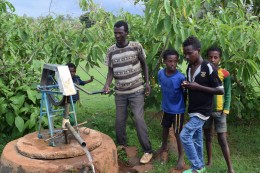
The 24 innovation labs gathered under the U.S. Government’s Feed the Future initiative are strongly expected to collaborate and bring synergies to address the problems caused by climate change with the aim of increasing food production for a growing population in the countries where they work.
Ethiopia is one of the Feed the Future focus countries with nine active labs (see this fact sheet). The Sustainable Intensification Innovation Lab (SIIL) is one of these nine labs working in the country, through a sub-grantee, the Texas A&M Universityand its director Neville Clarke.
Clarke is also leading the Innovation Lab on Small Scale Irrigation (ILSSI), which has been active in Ethiopia for over two years. ILSSI and SIIL are collaborating in Ethiopia through a grant from SIIL known as ‘Sustainably intensified production systems impact on nutrition’ (SIPS-IN). This grant complements the ILSSI and involves the same partners as well as Tufts University School of Medicine in Boston and Bahir Dar University in Ethiopia.
Bahir Dar University is also hosting the ‘Research and design of small tools for commercial vegetable home gardens’ project of the Appropriate Scale Mechanism Consortium (ASMC). Led by the University of North Carolina Agricultural and Technical State University (NCA&T), the project is developing tools to reduce the time spent on farm labor to make more efficient use of the efforts of women farmers in home gardens. This initiative targets improved vegetable production using conservation agriculture and drip irrigation.
These three initiatives are complementing each other to improve food production in Ethiopia:
- ILSSI is developing field studies on small-scale irrigation, expanded livestock (fodder) interventions and expanded ‘kitchen gardens’ (commercial home gardens)
- ILSSI is also developing household surveys, together with Tufts University to evaluate nutritional impacts
- ILSSI has been expanding its small-scale irrigation system analysis to support SIPS-IN
- All this work is leading, for SIPS-IN and SIIL, to generate integrated and site-specific (production, environmental, economic and nutritional) results and impacts, identifying adequate farming methods and tools that are applicable to the SIIL portfolio, and providing indications about potential scaling to other areas.

Why this collaboration matters
This collaboration uses a common set of field experiments, coupled with household surveys of the farming families involved in these studies. It also uses an integrated modeling system that, taken together, provides new sustainably intensified production systems for smallholder farmers, tools to help women farmers reduce labor and make them more efficient and improves the nutrition of families employing these new production methods.
The projects are also bringing together a complementary team of scientists. Behavioral specialists are looking at effects of technologies, environmental scientists are looking at the consequences of intensifying agricultural production, etc. By working together, the scientists will better understand the interesting insights about trade-offs and optimization options, the consequences of the economic models adopted in the project and more. In time, data from the project should be able to reveal the amount of water available in a certain location, and how irrigation can be applied; both to what extent and for what results.
Taken together, the studies from these three initiatives’ will identify important geographic characteristics and reveal options for scaling up in areas that feature similar characteristics.
Finally, for the funding partners, this collaboration will bring about an efficient system that avoids or reduces duplication of efforts (e.g. in carrying out common baseline studies).
Bottlenecks and stepping stones
This collaboration will present challenges including the management of a large amount of qualitative data that will be generated.
“Data is our friend and our enemy,” according to Clarke.
Another difficulty lies with the factors of adoption for technologies. Farmers are risk-averse and most of the farming in Ethiopia is done by women who experience other social disadvantages. They may not own a cell phone or may struggle to access credit, which limits their contribution to sustainable intensification efforts.
Despite these challenges, Clarke is confident that the connection between the three projects will bring benefit to Ethiopia, but also Tanzania and Ghana — the other SIIL and ILSSI target countries.
The next stepping stone for this collaboration is to emphasize technology transfer and use or “create” private-sector opportunities, to make the project results sustainable. For now, the modeling work of ILSSI and SIPS-IN is helping predict where there is adequate water and the first round of integrated modeling already shows the favorable investment areas for sustainable intensification.
In the next few years, the project team is expected to generate finer results that will hopefully translate into tangible improvements for farmers in Ethiopia.


